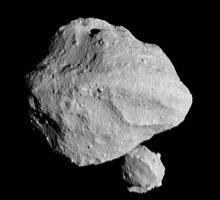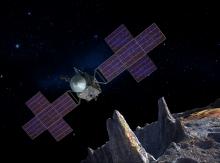Listen to today's episode of StarDate on the web the same day it airs in high-quality streaming audio without any extra ads or announcements. Choose a $8 one-month pass, or listen every day for a year for just $30.
You are here
Vesta
Vesta is the second-largest member of the asteroid belt, but it may be the best understood. A spacecraft orbited the little world for more than a year. And pieces of it have been found here on Earth — more than 1200 of them.
On average, Vesta is about 330 miles in diameter — about half the size of Ceres, the giant of the asteroid belt. But it passes closer to Earth, and its surface is brighter, so it’s easier to see and study.
The Dawn spacecraft arrived at Vesta in 2011. It found that Vesta consists of layers of rock and metal, like a planet. It also found that liquid water once flowed across the surface, and that frozen water may lurk below the surface even today.
Dawn also discovered a giant crater at the south pole. It’s hundreds of miles across and about eight miles deep. It probably was gouged by a collision with another asteroid less than a billion years ago. Chunks of debris from the impact form a family of small asteroids.
Even smaller bits from the impact may have made it all the way to Earth. They form a class of meteorites that match Vesta’s composition. They reveal details about Vesta’s early history — helping make it the best-known asteroid in the solar system.
This is a good time to study Vesta because it’s lining up opposite the Sun. It’s in view all night, and is brightest for the year. It’s just below naked-eye visibility. Through binoculars, it looks like a faint star near the back leg of Leo, the lion.






